Bramford
"Took a walk around Bramford School recently, spotted these words at
the far end. The school is on the left after the bridge at the bottom
of the hill next to the hall as you enter Bramford. Gordon (Pugh)"
[Our thanks to Gordon for
introducing a page to this site about Bramford, near neighbour of – but
separate to – Ipswich.]
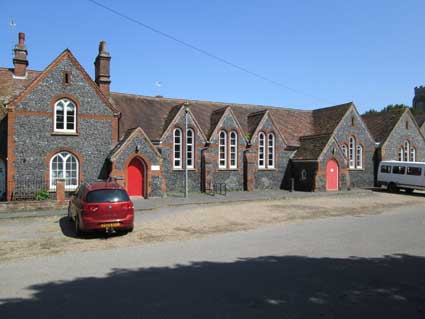
'THIS STONE WAS LAID
ON THE 31 DAY OF OCTOBER
A..D. 1860
BY SIR G.N. BROKE BART.,
C.B.
BY WHOM THE GROUND WAS GIVEN
THE ERECTION OF THIS SCHOOL
UPON IT BEING DUE TO THE
LIBERALITY AND ZEAL OF
THE REV. W. BEDFORD, VICAR
AND THE INHABITANTS OF THE
PARISH OF BRAMFORD.'
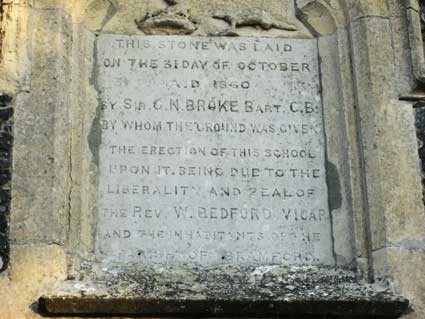 c.2012 images courtesy Gordon Pugh
c.2012 images courtesy Gordon Pugh
'THIS CLASSROOM
WAS ERECTED
A.D. 1897.
AS A MEMORIAL OF THE
60TH REIGN OF
VICTORIA
BY THE GRACE OF GOD
QUEEN AND EMPRESS
1837 – 1897'
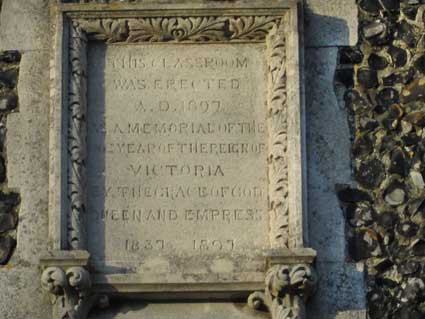
Scroll down for the 2019 restorations.
The Bramford Local History Group (see Links)
has an interesting commentary on these school plaques:-
"Extract from the Ipswich Journal 3rd November 1860:
'LAYING THE MEMORIAL STONE OF THE CHURCH OF ENGLAND SCHOOLS, AT BRAMFORD
The education of the poor in the rural districts is now carried on by
the clergy with great energy and success. Nothing has been more
striking, in the last twenty years, than the rapid rise of the present
system of parochial schools. In most every village we meet with
pretty little school-houses, built in all sorts of materials and styles
of architecture; indeed, it has become a matter of some difficulty to
find a village of any note without parish school. Bramford has
lingered somewhat in the rear of more favoured places; but thanks to
the energy of the present vicar, the Rev. W. Bedford, and the
liberality of Sir George Broke-Middleton, and other landowners and
inhabitants, the village has now as large and well appointed
school-house as any parish in the county. Bramford is a large
parish, having an area of 3,168 acres, and a population of 997, in
1851; its population having doubled since the commencement of the
present century. It is not an exclusively agricultural parish,
for it contains a mill for the manufacture of coarse paper, and the
extensive manure works of Mr. Packard and the Messrs. Chapman; lime
works, and other branches of manufacturing industry, are also carried
on in the place; and now, side by side with all this material
prosperity, it is gratifying to be able to add, school accommodation
for the children of all the working men in the parish. The school
buildings, which are situated near the Church, consist of a suite of
large and lofty rooms, with a house for the master and mistress
attached. The land upon which the buildings are situated was
given by Sir Geo. Broke-Middleton, Bart., and the buildings were
erected by funds derived from public subscription, together with other
grants. The total cost of the building was £725. Towards
this sum £353 had been received as a grant from government, £25 was
received from the National Society, and £50 from the Diocesan Society,
and the remainder was raised by local subscriptions, with the exception
of £50, which remain in arrear up to Wednesday last, when the schools
were opened.
The proceedings of the day commenced at the Church, where divine
service commenced at two o’clock. The Rev. W. Bedford, the vicar
of the parish, read prayers; after which the Rev. F. H. Maude,
incumbent of Holy Trinity, Ipswich, preached a sermon in aid of the
funds.
The Church was filled to overflowing, many of the congregation being
obliged to stand throughout the service. Amongst those present we
observed Sir Fitz-Roy Kelly, Sir George and Lady Broke-Middleton, the
Rev. Ambrose Steward and family, Revds. W. Howarth, E. Daniel, A. H.
Synge, E. J. Lockwood, J. E. Thompson, - Taylor, - Mowatt, J. M.
Theobald, E. Bolton, and many other clergymen and gentry of the
neighbourhood.
(A very detailed account of the
sermon followed here)
We are happy to be able to say that the collection at the close of the
service amounted to £18 9s; out of this sum 16s. 4d. was given in pence.
It is very general, in matters of this kind, to have some kind of
commemorative service at the laying of the first stone of the building;
but at Bramford it was the last, or “memorial” stone of the schools,
which was the subject of ceremony on Wednesday. Of course with
funds so narrow as the figures we have quoted, in this case it was not
possible to make any great architectural show. The building is,
however, a very pretty specimen of that style of architecture which has
come so much into vogue of late years, and which is perhaps a not very
pure reproduction of the Tudor style. The master’s house stands
at one end, and is two stories high. The schoolrooms are situated
in the rear of this, and consist of one story only, but they are very
lofty. They are lighted on one side by double –light windows
which rise into gables in the roof – relieving the monotony of the
plain-tiled surface, and giving a very pleasing effect to the whole
building. At the end opposite to the master’s house there is a
corresponding gable, and in this gable a large slab is worked with the
... inscription.
...
This stone is surrounded by the Broke and Middleton arms, carved in
bold relief, and wrought into the form of a Gothic arch [see below*];
and the key-stone of the arch was the same that Sir George
Broke-Middleton laid on Wednesday. A handsome silver trowel was
presented to him on the occasion, bearing the following inscription:-
“Presented to Sir George Broke-Middleton, Bart., on his laying of the
Memorial Stone of the Church of England Schools, at Bramford”
The bells of the Church were ringing out a merry peal, and a large
number of the inhabitants were present to witness the ceremony.
Great numbers were working men, who were evidently making holiday for
the occasion. It seemed indeed, as if the parishioners took the
preacher at his word and looked upon the occasion as one of deep and
heartfelt rejoicing. The ringing ceased, and after a short prayer
by the Vicar, Sir George worked the stone into its place, assisted by
the builder, and Mr. Barnes the architect.
The Honourable BARONET then turned to the audience, and spoke nearly as
follows:-
Ladies and Gentlemen: I declare the memorial stone of this school to be
duly laid. There has been a little difficulty – owing, perhaps to
the clumsiness of the workmen – but I hope, although a long time has
been spent in laying it, it will be the longer in being
displaced. I feel that I need say but very few words after the
eloquent sermon which you have just heard. I feel it a high
privilege to have been called upon to lay the stone, and I am heartily
pleased at the manner in which the people of this parish have come
forward to support their minister in this work. If it had not
been for him you would never have had the pleasure of meeting here for
this purpose. I trust that the parents of the children will heed
the words which they have heard today. I hope they will assist
their minister in this work, by sending their children to school as
much as they can. I now call upon you to give three cheers as a
proof that you will do so.
Three cheers were given; after which the Rev. Mr BEDFORD came forward
and said:
I am very glad to see so many of you here to-day. I think, my
friends, you will join with me in thanking Sir George for what he has
done for us. You know, as well as I do, that his work did not
begin here today. He came over when he heard we were
contemplating erecting schools –(I did not hear that he spoke to
anyone, I am sure he did not speak to me) – and set apart this piece of
land for us at a time when we did not know where we should get a site
for our schools. He is a little mistaken in telling you that so
much of the credit is due to me. I have been very liberally
seconded in the matter, and I owe my thanks to you all for the
assistance you have offered me. The children are to have a treat
in the school-room from Sir George Broke-Middleton – I dare say they
are very anxious to get there. I hope that a blessing will rest
upon all who have taken a part in this good work, and that it may prove
to a blessing to future generations. I will not detain you; but
that Sir George may not forget this day, I am deputed to present him
with this trowel. I call for three cheers for Sir George
Broke-Middleton.
The cheers were given, and the company then entered the school-room,
where the children assembled to take tea. They were arranged at
their desks, and, before the proceeding with their repast, they sang
“Rule Britannia”, and several popular songs in very pleasing
style. The day had been delightfully fine, and from the children
at their tea to Sir George Broke- Middleton himself, all seemed to have
entered soberly and seriously into the true spirit of the undertaking.'
...
*Unless the stone was altered later (when the additional classroom
was added in 1875) the surround does not look as elaborate as that
described above. There appears to be two badly weathered crests
above the stone, one of an arm grasping a trident and the other is a
Brock or Badger, the latter being a play on the name Broke. Both
of these crests are associated with the Broke or Broke-Middleton
families.
The Broke, later Broke–Middleton Baronetcy, of Broke Hall, was a title
in the Baronetage of Great Britain. It was created on 2 November
1813 for Rear Admiral Philip Broke. He was the grandson of Robert
Broke, nephew of Sir Robert Broke, 1st Baronet, of Nacton who were both
descended from Sir Richard Broke, Chief Baron of the Exchequer to Henry
VIII. The second Baronet was High Sheriff of Suffolk in 1844 and his
younger brother, George, the third Baronet, was High Sheriff of Suffolk
in 1864. The third Baronet assumed the additional surname of Middleton
in 1860 after inheriting the estate of his cousin Sir William
Middleton. The title became extinct on his death in 1887. The fact that
that Sir George did not assume the additional surname of Middleton
until 1860 might explain why the stone is only inscribed with the name
“Broke” but he is referred to in the article as Broke-Middleton.
Rear Admiral Sir Philip Bowes Vere Broke, the first
Baronet, achieved
fame as a frigate captain during the 'War of 1812' with the United
States of America. Broke commanded HMS
Shannon and fought, and won, a
single ship action against the more heavily armed USS Chesapeake on the 1st June
1813."
[UPDATE 8.12.2019:
Albert Horn got in touch to draw our attention to the sprucing up of
these (and other) plaques: 'Renovated plaques and a couple more from
the same building which may or may not be of interest.
Albert.' Many thanks to him for the
photographs.]
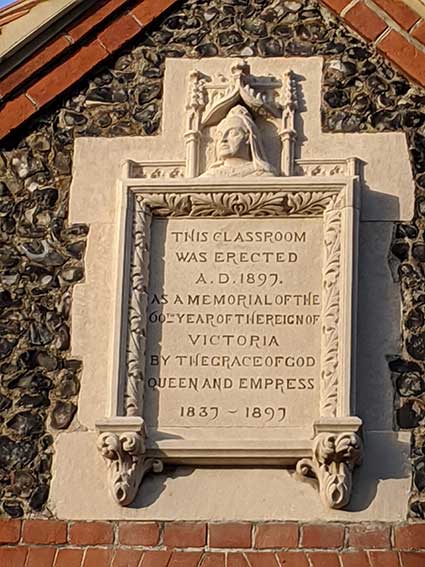 2019 images courtesy of Albert Horn
2019 images courtesy of Albert Horn
'THIS CLASSROOM
WAS ERECTED
A.D.1897.
AS A MEMORIAL OF THE
60TH YEAR OF THE REIGN OF
VICTORIA
BY THE GRACE OF GOD
QUEEN AND EMPRESS
1837-1897'
'THIS SCHOOL WAS ENLARGED
BY THE ADDITION
OF A CLASS ROOM
A.D. 1873.'
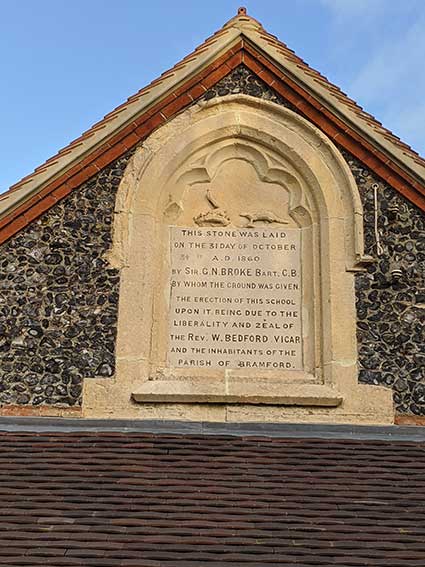
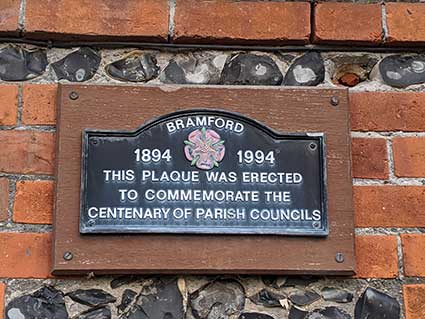
So, the overall sequence of dates is: 1860 (first building),
1873 (additional classroom), 1897 (additional classroom), 1994 (parish
councils centenary).
Home
Please email any comments and contributions by clicking here.
Search Ipswich
Historic Lettering
©2004 Copyright
throughout the Ipswich
Historic Lettering site: Borin Van Loon
No reproduction of text or images without express written permission
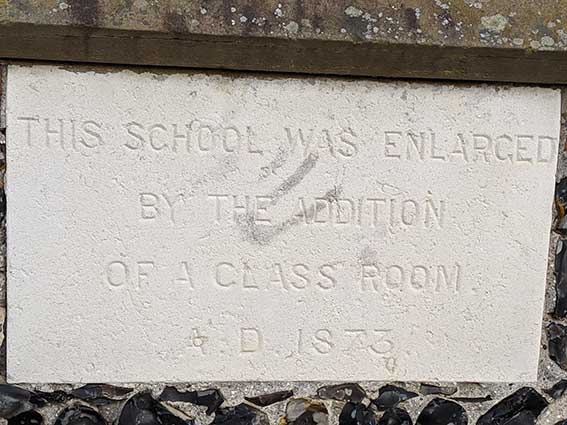

 c.2012 images courtesy Gordon Pugh
c.2012 images courtesy Gordon Pugh
 2019 images courtesy of Albert Horn
2019 images courtesy of Albert Horn

